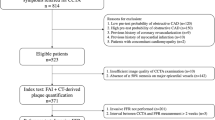Abstract
Fractional flow reserve (FFR) is an index for identifying functionally significant stenotic lesions. A FFR value of ≤0.75 is considered clinically significant and indicative of physiological ischemia. Focal lesions with 30–80 % stenosis by angiography with lesion lengths of less than 20 mm were selected from left anterior descending arteries of 74 patients. The analysis for the total lesion was processed first, and then each lesion was divided into three segments to assess the each segment. Data on plaque geometry and composition of two FFR groups, FFR ≤ 0.75 and FFR > 0.75, were compared by total and segmental analysis. Lesions with FFR ≤ 0.75 had more fibrofatty tissue (13.5 ± 7.4 vs. 10.2 ± 6.5 %, p = 0.05) and less dense calcium (7.2 ± 5.3 vs. 11.9 ± 7.5 %, p = 0.01) compared to lesions with FFR > 0.75. The content of necrotic core in mid segments was higher compared to proximal and distal segments (22.9 ± 10.6, 20.2 ± 10.9, 17.1 ± 11.2 %, respectively, p = 0.032) in lesions with FFR > 0.75 but the difference was less obvious in lesions with FFR ≤ 0.75 (17.9 ± 9.9, 18.7 ± 9.9, 15.8 ± 9.0 %, respectively, p = 0.533). Coronary lesions with FFR > 0.75 have larger content of dense calcium and slightly less fibrofatty tissue compared to lesions with FFR ≤ 0.75. While segmental plaque compositions for each segment show noticeable variations in lesions with FFR > 0.75 such as high concentrations of necrotic core in mid segment, these differences in each segment become obscure in FFR ≤ 0.75 and are evenly distributed across the lesion.


Similar content being viewed by others
Abbreviations
- ACS:
-
Acute coronary syndrome
- CaFA:
-
Calcified fibroatheroma
- CaTCFA:
-
Calcified thin-cap fibroatheroma
- DC:
-
Dense calcium
- DS:
-
Diameter stenosis
- FA:
-
Fibroatheroma
- FF:
-
Fibrofatty tissue
- FFR:
-
Fractional flow reserve
- FC:
-
Fibrocalcific plaque
- FI:
-
Fibrotic plaque
- FT:
-
Fibrous tissue
- LA:
-
Lumen area
- LAD:
-
Left anterior descending
- LL:
-
Lesion length
- MACE:
-
Major adverse cardiac events
- MLA:
-
Minimum lumen area
- MLD:
-
Minimum lumen diameter
- NC:
-
Necrotic core
- PCI:
-
Percutaneous coronary intervention
- PIT:
-
Pathological intimal thicknening
- QCA:
-
Quantitative coronary angiography
- ROC:
-
Receiver operating characteristic
- RVD:
-
Reference vessel diameter
- TCFA:
-
Thin-cap fibroatheroma
- VH-IVUS:
-
Virtual histology intravascular ultrasound
References
Waksman R, Legutko J, Singh J et al (2013) FIRST: Fractional Flow Reserve and Intravascular Ultrasound Relationship Study. J Am Coll Cardiol 61:917–923. doi:10.1016/j.jacc.2012.12.012
Maehara A, Mintz GS, Bui AB et al (2002) Morphologic and angiographic features of coronary plaque rupture detected by intravascular ultrasound. J Am Coll Cardiol 40:904–910
Brugaletta S, Garcia-Garcia HM, Shen ZJ et al (2012) Morphology of coronary artery lesions assessed by virtual histology intravascular ultrasound tissue characterization and fractional flow reserve. Int J Cardiovasc Imaging 28:221–228. doi:10.1007/s10554-011-9816-3
Mintz GS, Nissen SE, Anderson WD et al (2001) American College of Cardiology clinical expert consensus document on standards for acquisition, measurement and reporting of intravascular ultrasound studies (ivus): A report of the american college of cardiology task force on clinical expert consensus documents developed in collaboration with the european society of cardiology endorsed by the society of cardiac angiography and interventions. J Am Coll Cardiol 37:1478–1492. doi:10.1016/S0735-1097(01)01175-5
Huisman J, Egede R, Rdzanek A et al (2010) Between-centre reproducibility of volumetric intravascular ultrasound radiofrequency-based analyses in mild-to-moderate coronary atherosclerosis: an international multicentre study. EuroIntervention 5:925–931
Garcia-Garcia HM, Mintz GS, Lerman A et al (2009) Tissue characterisation using intravascular radiofrequency data analysis: recommendations for acquisition, analysis, interpretation and reporting. EuroIntervention 5:177–189
Pijls NH, De Bruyne B, Peels K et al (1996) Measurement of fractional flow reserve to assess the functional severity of coronary-artery stenoses. The New England journal of medicine 334:1703–1708. doi:10.1056/nejm199606273342604
Jang HJ, Koo BK, Lee HS et al (2013) Safety and efficacy of a novel hyperaemic agent, intracoronary nicorandil, for invasive physiological assessments in the cardiac catheterization laboratory. Eur Heart J 34:2055–2062. doi:10.1093/eurheartj/eht040
Rodes-Cabau J, Gutierrez M, Courtis J et al (2011) Importance of diffuse atherosclerosis in the functional evaluation of coronary stenosis in the proximal-mid segment of a coronary artery by myocardial fractional flow reserve measurements. Am J Cardiol 108:483–490. doi:10.1016/j.amjcard.2011.03.073
Abizaid AS, Mintz GS, Mehran R et al (1999) Long-term follow-up after percutaneous transluminal coronary angioplasty was not performed based on intravascular ultrasound findings: importance of lumen dimensions. Circulation 100:256–261
Koo BK, Yang HM, Doh JH et al (2011) Optimal intravascular ultrasound criteria and their accuracy for defining the functional significance of intermediate coronary stenoses of different locations. JACC Cardiovascular interventions 4:803–811. doi:10.1016/j.jcin.2011.03.013
Stone GW, Maehara A, Lansky AJ et al (2011) A prospective natural-history study of coronary atherosclerosis. The New England journal of medicine 364:226–235. doi:10.1056/NEJMoa1002358
Pu J, Mintz GS, Brilakis ES et al (2012) In vivo characterization of coronary plaques: novel findings from comparing greyscale and virtual histology intravascular ultrasound and near-infrared spectroscopy. Eur Heart J 33:372–383. doi:10.1093/eurheartj/ehr387
Sales FJ, Falcao BA, Falcao JL et al (2010) Evaluation of plaque composition by intravascular ultrasound “virtual histology”: the impact of dense calcium on the measurement of necrotic tissue. EuroIntervention 6:394–399. doi:10.4244/eijv6i3a65
Author information
Authors and Affiliations
Corresponding authors
Ethics declarations
Conflict of interest
None.
Rights and permissions
About this article
Cite this article
Chung, JH., Ann, S.H., Singh, G.B. et al. Segmental assessments of coronary plaque morphology and composition by virtual histology intravascular ultrasound and fractional flow reserve. Int J Cardiovasc Imaging 32, 373–380 (2016). https://doi.org/10.1007/s10554-015-0794-8
Received:
Accepted:
Published:
Issue Date:
DOI: https://doi.org/10.1007/s10554-015-0794-8




